How Much Vegtables Should I Feed My Guinea Pig

Did you know that guinea pigs have been incorrectly named? First of all, they don't come from New Guinea—they actually originated in Peru in the Andes Mountains. And then secondly, they are not related to pigs in any way. It is believed that they were named "pig" because of the cute little squealing noise they make that sounds somewhat piglike.
Your guinea pig's diet, like with any pet, is of the utmost importance. You want to be sure that you're fulfilling your cavy's daily dietary requirements and that you're not feeding him anything that isn't good for him.
Well, we're going to explore everything diet-related for guinea pigs so you can provide your pet with the healthiest diet possible. We all want our cavies to thrive.

What to Feed Guinea Pigs
We're going to go over the different kinds of foods your guinea pig can and cannot eat. The most essential food in the cavy diet is hay. In fact, 80% of their diet should be composed of hay—Timothy hay is usually best.
Vegetables and herbs make up 10%-15% of their diet, and pellets about 5%-10%. And all with the occasional treat thrown in.

Vegetables High in Vitamin C for Guinea Pigs
All of the above vegetables are high in vitamin C, which is an essential vitamin for guinea pigs. You should offer about 1 cup of fresh vegetables from this list every day for each guinea pig.

The following list is veggies that are safe for guinea pigs to eat but are lower in vitamin C:
Vegetables Low in Vitamin C for Guinea Pigs
- Celery
- Mint
- Basil
- Dill
- Thyme
- Chicory
- Endive
- All lettuce (except for iceberg)
- Yams
- Carrots
- Asparagus
- Beansprouts
- Raw corn
- Radishes
- Turnips
- Beets
- Pumpkin
Because these veggies aren't as high in vitamin C, they should only be offered once or twice a week.
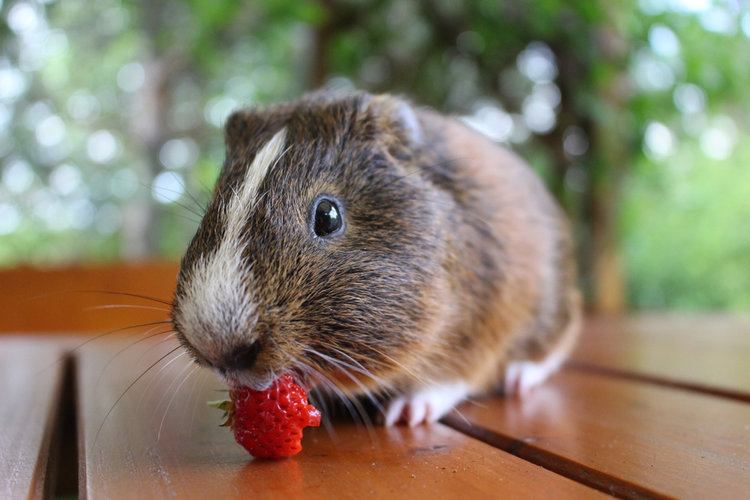
Fruit High in Vitamin C for Guinea Pigs
- Kiwi
- Grapes
- Oranges/tangerines
- Strawberries
- Pomelo
- Pineapple
- Mango
- Guava
The fruit from this list is good for your guinea pig since they are all high in vitamin C, but because they are also high in sugar (even if the sugar is natural), they should be limited to once a day or no more than a few days a week.
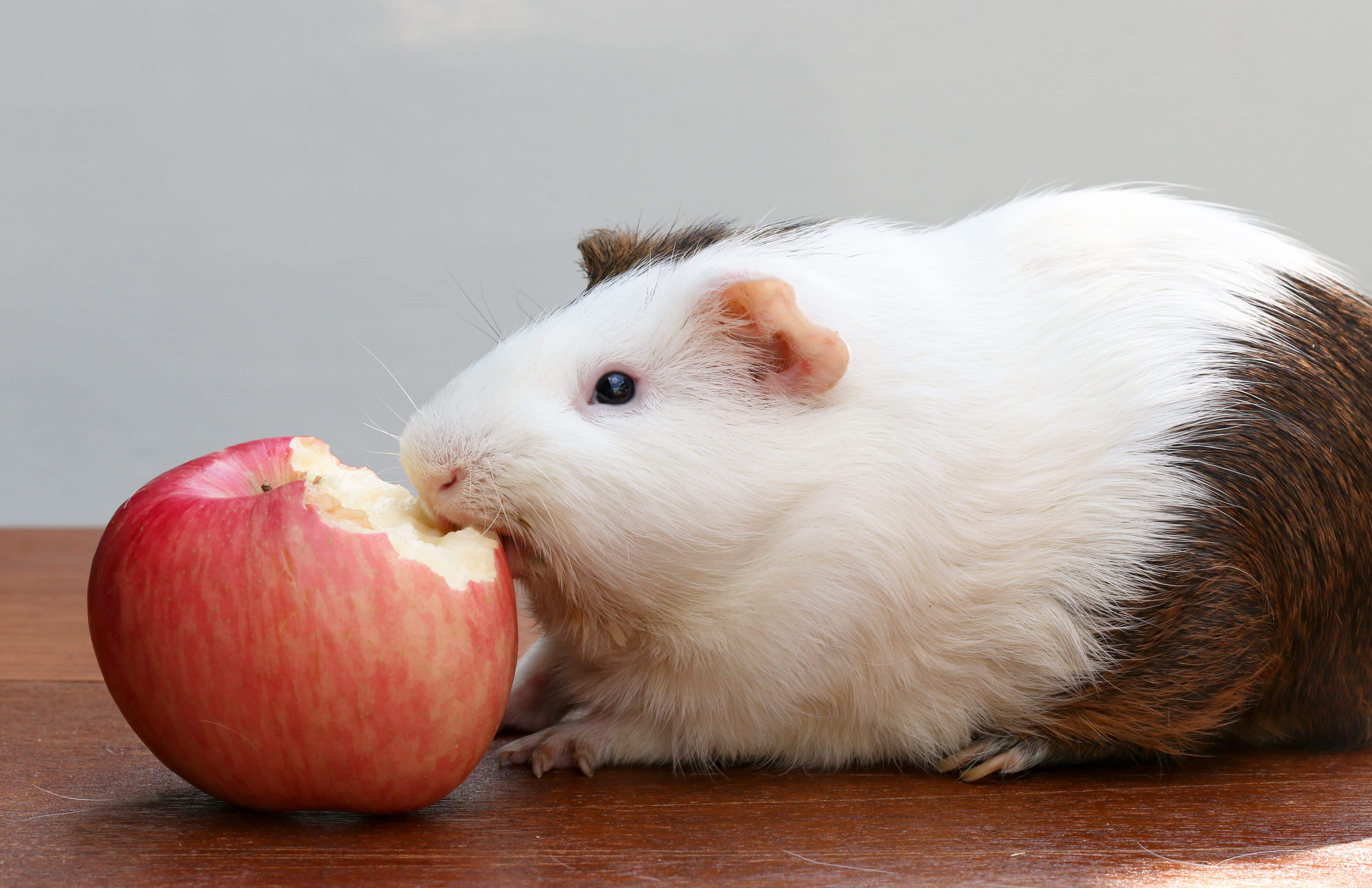
Fruit Low in Vitamin C for Guinea Pigs
- Apples
- Apricots
- Peaches
- Pears
- Plums
- Passion Fruit
- Cherries
- Watermelon
- Bananas
- Raspberries
- Blueberries
- Blackberries
Again, like the veggies low in vitamin C, go easy on the fruit and just provide, for example, a few blueberries, or thin slices of apple, banana, or oranges as occasional treats a few times a week.

Food Not Good for Guinea Pigs
- Grains
- Meat
- Dried beans
- Peas
- Seeds
- Nuts
- Chili peppers
- Lilies
- Buttercups
- Shrubs such as privet or hemlock
- Mushrooms
- Potatoes
- Garlic
- Onions
- Peanut butter
- Avocado
- Daffodils
- Rhubarb leaves
- Foxglove
- Human food (such as dairy, chocolate, crackers, bread, pasta, cereal, and anything with added sugar)
Many of these items should be obvious as to why they aren't good for guinea pigs. You should avoid giving your cavy any food that will cause gas, such as cauliflower and cabbage.
Iceberg lettuce can cause diarrhea, onions (and anything in the onion family) can lead to a blood disorder, garlic is toxic, and avocado is too high in fat.
New food needs to be added to your guinea pig's diet very slowly, or he might become ill. They need time to adjust to any new food, so always introduce it slowly, just adding tiny amounts and gradually increasing over time.
How Much Water?
Just like for almost every living thing on the planet, water is essential for guinea pigs. Do not add anything to the water—no vitamins, minerals, or supplements. Water should be provided in water bottles designed for rodents, and they should have access to fresh water 24 hours a day.
This means filling the bottle once a day with fresh water and always checking that the water bottle is working properly and that it hasn't run out. Consider investing in a larger bottle if your water is consistently running dry throughout the day.

Guinea Pig Feeding Chart
| Guinea Pig Feeding Schedule | Food |
| Monday | |
| *with fresh water, hay, and pellets | Broccoli |
| Cucumber | |
| Parsley | |
| Lettuce mix | |
| Fruit Day! | |
| Tuesday | |
| *with fresh water, hay, and pellets | Red pepper |
| Carrots | |
| Coriander | |
| Lettuce mix (try endive!) | |
| Wednesday | |
| *with fresh water, hay, and pellets | Parsnip |
| Celery | |
| Parsley | |
| Lettuce mix | |
| Fruit Day! | |
| Thursday | |
| *with fresh water, hay, and pellets | Zucchini |
| Cucumber | |
| Broccoli | |
| Lettuce mix (try radicchio!) | |
| Friday | |
| *with fresh water, hay, and pellets | Green pepper |
| Carrots | |
| Coriander | |
| Lettuce mix | |
| Saturday | |
| *with fresh water, hay, and pellets | Tomatoes |
| Cucumber | |
| Parsley | |
| Lettuce mix | |
| Fruit Day! | |
| Sunday | |
| *with fresh water, hay, and pellets | Celery |
| Carrots | |
| Coriander | |
| Lettuce mix |
Source: https://www.animallama.com/guinea-pigs/guinea-pig-feeding-schedule/
This chart is just an example of what your cavy could eat throughout the week. By using the lists further up, you can make changes and adjust as you see fit.
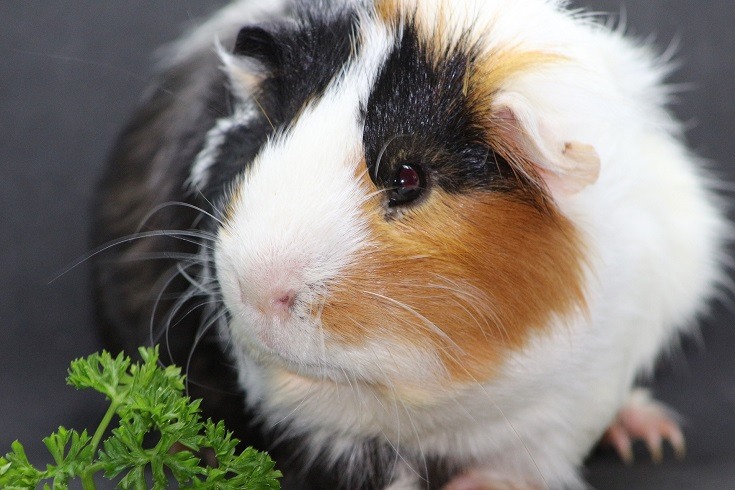
When to Feed Guinea Pigs
Because Timothy hay is such a vital part of the guinea pig's diet, it should be made available at all times.
Other than the hay, it's a good idea to feed your cavy two times a day. Both in the morning and in the evening, to help prevent overeating and, consequently, obesity. Always remove any uneaten pellets about 1 hour after your cavy has eaten and any fruit or vegetables after 24 hours.
This also includes any hay—always discard old hay before you add in the fresh.
Related Read: How Long Can a Guinea Pig Go Without Food & Water?
Is Vitamin C Good for Your Guinea Pig?
Vitamin C is absolutely essential for your cavy! Like us humans, guinea pigs are unable to produce their own vitamin C, so it's crucial to add vitamin C to supplement their diet. Without this vital vitamin, guinea pigs are prone to scurvy.
Signs of vitamin C deficiency include:
- Diarrhea
- Weight loss
- Hair loss and skin problems
- Sneezing
- Crusty eyes
- Difficulty walking
- Swollen joints and feet
- Ulcers on skin or gums
Your cavy should be seen by a vet if you notice any of these symptoms.
There are supplements you can give your guinea pig, but as long as you are giving him a proper diet, including vitamin C-rich fruit and vegetables, that should be sufficient.
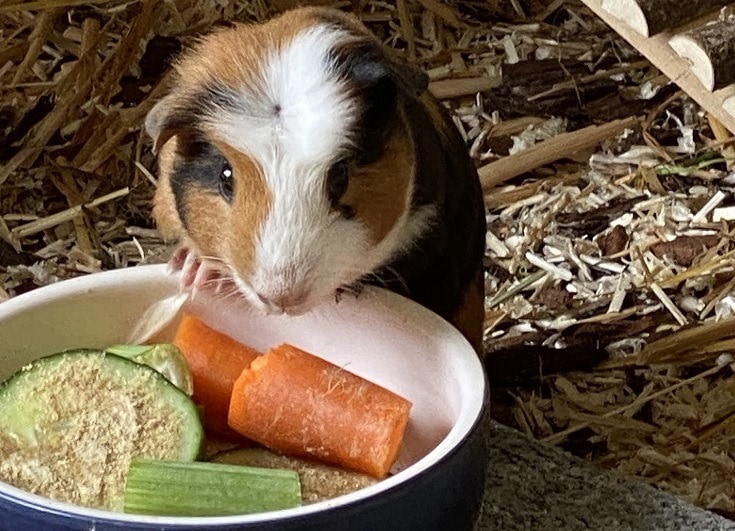
How to Choose Nutritious Supplements for Your Guinea Pig
Of course, you'll want to select high-quality food for your guinea pig to keep him in optimal health. Look for good grass hay since, as you already know, it makes up the majority of your cavy's diet. Timothy hay is preferred, and it should be fresh, green, no dust, and have a sweet scent.
Opt for uniform pellets (the pellets are all the same and not in a mix) over a mixed-base diet and make sure that any commercially made food does not contain any refined sugars. You should also look out for any supplements that will provide your cavy with chelated minerals, prebiotics, and natural preservatives.
- See Also: Which Guinea Pig Breed Is the Friendliest?
What Are the Best Natural Treats for Guinea Pigs?
The best treats for your guinea pig can just be as simple as giving him a small portion of fruits or vegetables that he doesn't have very often, as long as they are on the safe list. You could even opt to make a game out of their regular food, such as stuffing some fresh hay into a cardboard tube (that they can fit into, of course).
You could buy some commercial treats for your cavy, but it isn't really necessary when he will be thrilled with a blueberry or slice of carrot.
Don't forget to only give him a tiny amount to start if it's the first time your guinea pig has eaten this treat. You don't want your cavy with an upset stomach.
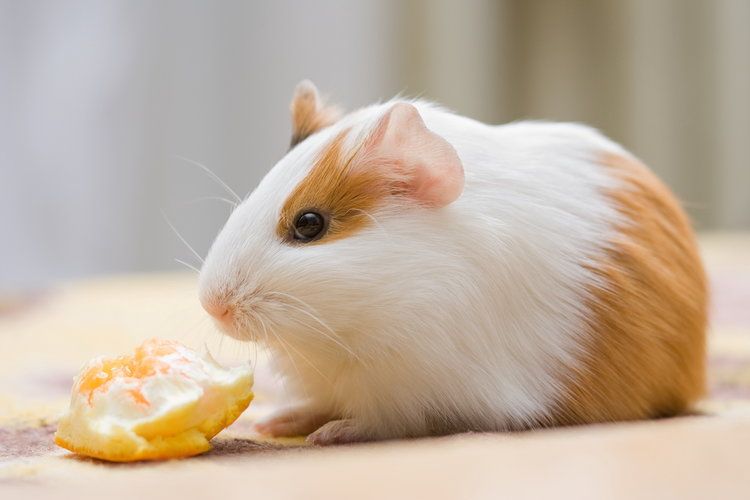
What to Do if Your Guinea Pig Isn't Eating
There are a number of reasons why your guinea pig might not be eating that range from illness to stress. Everything from an issue with their teeth to changes in the diet or even environmental changes could trigger a loss of appetite.
If you've noticed these symptoms, you should take your guinea pig to the vet as soon as possible:
- Lethargy
- Depression
- Weight loss
- Lessening of elasticity in his skin
- Water and food untouched
- Rough hair
- Fever and diarrhea (could indicate an infection)
The most common causes for a loss of appetite can include:
- Not enough fresh water
- Recent surgery
- Stress
- Changes in the diet
- Changes in the environment
- Underbite or overbite of teeth
- Infection
- Too hot or too cold in the environment (optimal is 65-75°F)
- Ketosis of the liver
If your pet only seems to have lost his appetite and doesn't have other symptoms, just ensure he's comfortable. Check the temperature and ensure there's no stress by keeping his enclosure clean and providing a nutritious, well-balanced diet. If you believe something more might be going on, take him to your vet.
You may also want to know: What Fruits Can Guinea Pigs Eat? What You Need to Know!

Conclusion
The diet of your pet is an absolutely vital part of keeping him healthy and happy. As long as you do your homework and understand what food is good for your guinea pig and what food you should avoid, you can develop your own unique and individual diet that will suit your cavy's preferences. We all want our pets to live an enjoyable and long life.
Related Read: Can Guinea Pigs Eat Rabbit Food? What You Need To Know!
Featured Image Credit: CC0 Public Domain, pxhere
Source: https://petkeen.com/guinea-pigs-feeding-chart-guide/
0 Response to "How Much Vegtables Should I Feed My Guinea Pig"
Enregistrer un commentaire